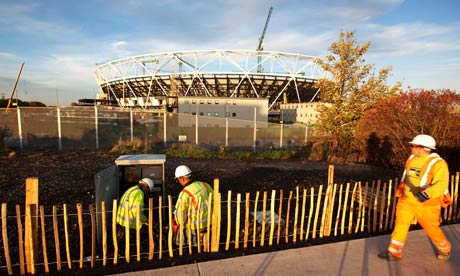Olympic site begins to take shape, but the Lea remains polluted

http://www.guardian.co.uk/uk/2009/oct/30/stratford-london-2012-olympics
The Guardian published another article on the Olympic transformation taking place in West Ham. Anna Kessel is impressed by the changes in the landscape and she looks forward to the time when the Lea is transformed into a more pleasant river. Interestingly enough, she is not the first person to bemoan the condition of the Lower Lea and its back rivers that flow through the 2012 Olympic site. In 1844, decades before the height of the industrial boom in West Ham, James Thorne, in his book Rambles by Rivers, talks about the Lower Lea and its degraded industrial condition:
But by this time our river has ceased to be either picturesque or interesting: lime-kilns, calico-printing, and distilleries are the most prominent objects along its banks; and however useful these may be, they are not agreeable to either nose or eye.
This quote is similar to Anne’s vision of the Lea from today:
Running through the middle of it all is the much-maligned river Lee, a polluted waterway that dutifully shoulders the burden of being a Londoner. Somehow it still manages to provide a home for waterfowl and wildlife despite the shopping trolleys and stolen mopeds that are regularly thrown into its flow. Right now it appears as sorry as ever, its banks strewn with sand and equipment. Its surface reflects back the desolate industrial expanse. Soon, though, it will be restored to its former glory, the mounds of earth smoothed down and carpeted over with emerald-green turf, dotted with trees.
Her hope that the Lea will soon be restored to its former glory, even if this area has no history as a well drained and landscaped Olympic park, also has a long tradition. William Morris wrote News From Nowhere in 1890 looking forward to a future when the Lea’s wetland returned to their “natural glory”:
…Beyond that the houses are scattered wide about the meadows there, which are very beautiful, especially when you get on to the lovely river Lea (where old Isaak Walton used to fish, you know) about the places called Stratford and Old Ford, names which of course you will not have heard of, though the Romans were busy there once upon a time.
… Past the Docks eastward and landward it is all flat pasture, once marsh, except for a few gardens, and there are very few permanent dwellings there: scarcely anything but a few sheds, and cots for the men who come to look after the great herds of cattle pasturing there. But however, what with the beasts and the men, and the scattered red-tiled roofs and the big hayricks, it does not make a bad holiday to get a quiet pony and ride about there on a sunny afternoon of autumn, and look over the river and the craft passing up and down, and on to Shooter’s Hill and the Kentish uplands, and then turn round to the wide green sea of the Essex marshland, with the great domed line of the sky, and the sun shining down in one flood of peaceful light over the long distance. There is a place called Canning’s Town, and further out, Silvertown, where the pleasant meadows are at their pleasantest: doubtless they were once slums, and wretched enough.
None of the comments are intended to critique this article, as I’m very happy to see the growing interest in West Ham and the Lower Lea. I just hope the reporters get past the glamour of the Olympic developments and venture out to see the condition of the rest of West Ham. I would also like them to pay more attention to the history of this space and the many attempts in the past to remake and clean up the Lower Lea.
